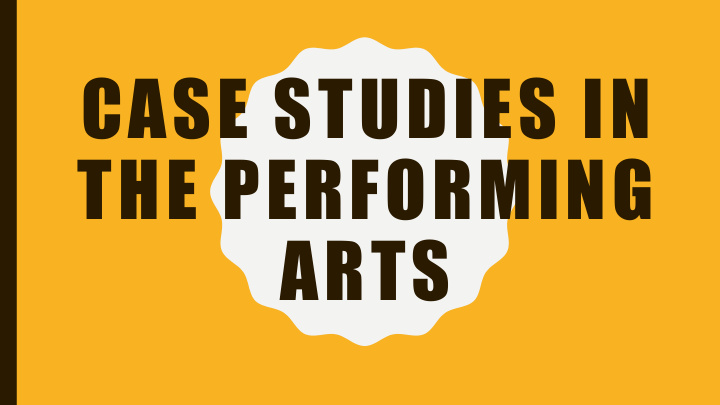



CASE STUDIES IN THE PERFORMING ARTS
DAN BROWN, MD, MPH • Disclosures – IU School of Medicine – Evansville – Voluntary Faculty – Parker-Brown Band – Blind Pig Studios
ME MEDICAL AL P PRO ROBLEMS O MS OF P F PERFO RFORMI RMING ARTI G ARTISTS STS • the first clinical medical journal devoted to the etiology, diagnosis, and treatment of medical and psychological disorders related to the performing arts. • Official journal of the Performing Arts Medical Association (PAMA), the Dutch Performing Arts Medicine Association (NVDMG), and the Australian Society for Performing Arts Healthcare (ASPAH).
PERFORMING ARTISTS TEND TO BE GROUPED INTO: • Artists who work • Artists who work with their hands, with their whole mouths, and voice bodies such as dancers and theater performers
HISTORY: THIS IS NOT A NEW PROBLEM! • Per the Medical Journal of Australia 1986: • Medical literature regarding overuse syndrome in musicians from 1830 to 1911 was reviewed including 21 books and 54 articles. • Two theories: • Central Theory: the lesion was regarded as being in the central nervous system. • Peripheral Theory: the condition as a primary muscle disorder
An Overview of Health Issues for Performing and Visual Arts Students May 2009 Reprint Council of Arts Accrediting Associations: National Association of Schools of Art and Design National Association of Schools of Dance National Association of Schools of Music National Association of Schools of Theatre
OVERUSE SYNDROMES ARE COMMON • 2013 study of the US Army Medical Command Band • 10 of 35 subjects had abnormal EPS studies of the median nerve at the wrist • 9 of the 10 had a clinical exam consistent with carpal tunnel syndrome
A COMMON PROBLEM • Survey of International Conference of Symphony and Opera Musicians (ICSOM) members: • 64% had painful oversuse syndromes • Prevalence from 75% among string players to 32% in percussionists • Keyboard players at high risk
FREQUENT PROBLEMS • Overuse Syndromes • Neural Impingement • Focal Dystonias • Psychological Issues
OVERUSE SYNDROMES These are symptom complexes of injuries caused by the cumulative effects on tissues of repetitive physical stress that exceeds physiologic limits. Common locations for overuse syndromes include the fingers, wrists, shoulders, neck, and low back.
NEURAL IMPINGEMENT Common sites are the wrist, forearm, elbow, shoulder, and neck. (Carpal tunnel, plexopathies, radiculopathies, etc.)
FOCAL DYSTONIAS • Dystonia is a movement disorder in which a person's muscles contract uncontrollably. The contraction causes the affected body part to twist involuntarily, resulting in repetitive movements or abnormal postures. • Most cases of dystonia do not have a specific cause. Dystonia seems to be related to a problem in the basal ganglia, the area of the that is responsible for initiating muscle contractions. The problem involves the way the nerve cells communicate.
VOICE PROBLEMS: • Voice problems include a multitude of issues including vocal cord nodules, polyps, and cysts. Infections and allergies affect the voice in obvious ways. • Laryngeal dystonias, also known as spasmodic dysphonia, can be very problematic for those who are professional singers and speakers
HISTOPATHOLOGY OF COMMON TENDINOPATHIES:
WHY DON’T YOU SEE THESE PEOPLE IN YOUR OCC MED PRACTICE? • T olerating pain is acceptable in the attempt to overcome technical problems. • Wash U 2013 Study of 261 musicians: • 93% had playing-related symptoms in the previous 12 months. 16% had symptoms that interfered with daily activities. • Only 3% filed a work-comp claim in their entire career!
HAND THERAPY CERTIFICATION COMMISSION Certified Hand Therapist (CHT)
CASE 1 Jim Green “The Wandering Endorphin”
JIM GREEN • Professional guitarist • Late 40s • Left upper extremity problems
CASE 2: TOM PLACIDO • Jazz pianist • Early 60s • Pain in right index finger distal phalanx
Tom showing extended wrists in his technique before Taubman.
Neutral position of wrists using the Taubman technique.
OKSANA POKOPENKO Oksana is an artist whose work includes the creation of religious icons in the tradition of the Russian Orthodox Church. Also known as icon writing. Oksana works in mosaics which involves cutting and placing of pieces of glass, some as small as a few mm. One icon contains thousands of pieces of glass
Tools
TOOL USAGE
Recommend
More recommend